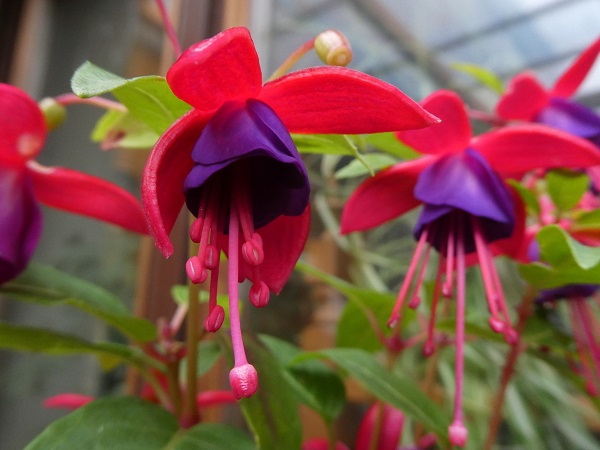
Fuchsias are popular greenhouse plants that are a genus of flowering plants in the family Onagraceae, which includes over 100 species and thousands of hybrids. Fuchsias are popular ornamental plants, known for their bright, pendulous flowers that come in a range of colors including pink, red, purple, and blue. Fuchsias are relatively easy to care for and grow, but they do require a moist environment and regular watering to thrive.
Care Instructions
Light
Fuchsias prefer bright, indirect light. Place them near a window or use artificial lighting to supplement.
Water
Fuchsias like to have evenly moist soil, but not waterlogged. Water the soil directly, avoiding getting water on the leaves to prevent leaf rot.
Soil
Use a well-draining potting mix that is rich in organic matter.
Fertilizer
Feed fuchsias with a balanced water-soluble fertilizer every 2-4 weeks during the growing season.
Temperature
Fuchsias prefer temperatures between 60°F to 75°F (15°C to 24°C).
Humidity
Fuchsias prefer high humidity levels, which can be achieved by placing a tray of water near the plant or using a humidifier.
Pruning
Prune fuchsias regularly to encourage bushy growth and remove any dead or yellowing leaves.
Propagation
Fuchsias are typically propagated through cuttings, layering, or division. Here’s how to propagate them using each method:
Cuttings
This is the most common method for propagating fuchsias. Cut a stem about 4-6 inches long, with a few leaves, just below a node (the point on the stem from which leaves emerge). Remove the bottom leaves, dip the cut end into rooting hormone powder, and plant it in a pot filled with moist rooting medium, such as a mixture of perlite and peat moss. Cover the pot with plastic wrap to create a humid environment and place it in bright, indirect light. Keep the rooting medium moist and in a few weeks, roots should have formed, and new growth should appear.
Layering
This method is best done in the spring or early summer. Bend a low-growing stem of a mature fuchsia plant to the soil level and cover the portion of the stem that’s in contact with the soil with soil or a rooting medium. The stem should root within a few months, and you can then cut it away from the parent plant and pot it up.
Division
If you have an overgrown fuchsia plant, you can divide it and propagate it that way. Carefully remove the plant from its pot and gently separate the roots into smaller sections, each with its own shoots. Replant each section into its own pot filled with fresh potting mix.
Regardless of which method you choose, be sure to keep your newly propagated fuchsias out of direct sunlight and keep the soil consistently moist, but not waterlogged, until they are established.
7 Fun Facts about Fuchsias
The plant was named after the German botanist Leonhart Fuchs, who lived in the 16th century.
Fuchsias are native to Central and South America, where they grow in tropical and subtropical regions.
The flowers of some fuchsia species are edible and have been used in traditional South American cuisine.
Fuchsias are not only prized for their ornamental value but also for their medicinal properties. In some cultures, the plant has been used to treat a variety of ailments, including skin irritations and eye problems.
Fuchsias are also popular among hummingbirds, who are attracted to their nectar-rich flowers.
In the Northern Hemisphere, fuchsias are often grown as annuals or as potted plants, as they are not frost-tolerant.
There is a National Collection of Fuchsias in the UK, which showcases over 2,000 different varieties of the plant.
Related Articles & Free Email Newsletter Sign Up
How to Grow & Care for the Lipstick Plant
Oxalis is a Great Plant for Your Greenhouse




Comment here